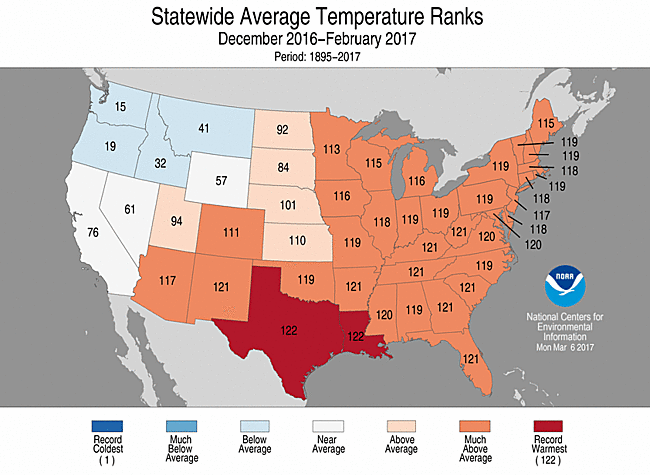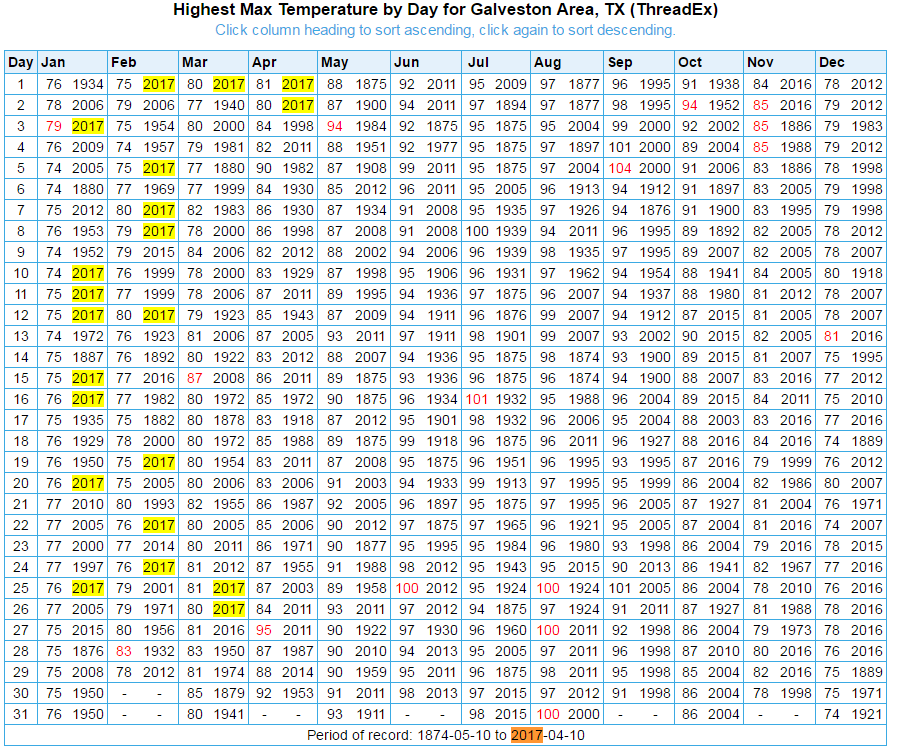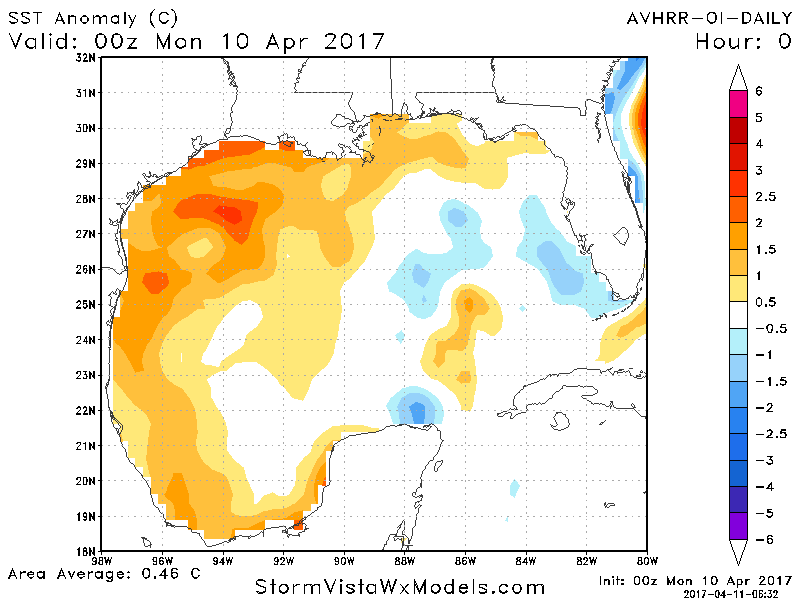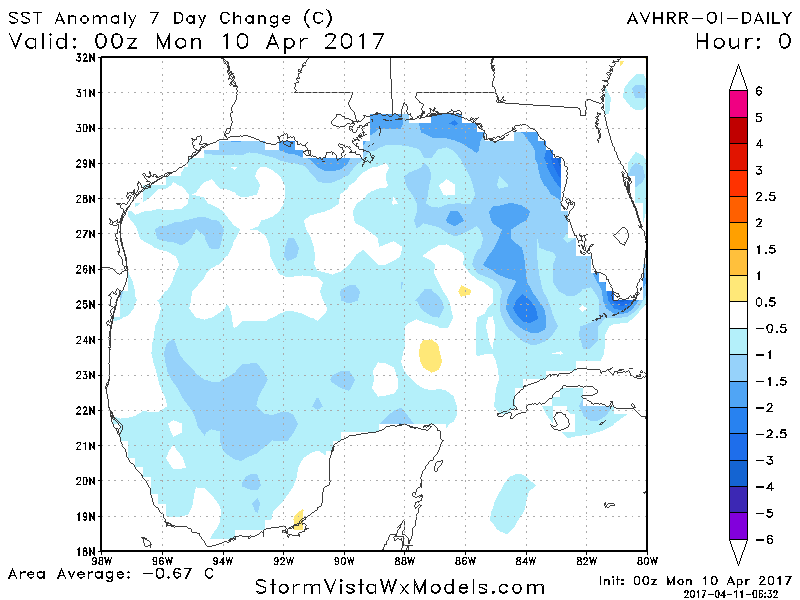This past winter was definitely a warm one that set records in many spots across the country, but some of the most amazing warmth has come close to home—in Galveston.

For Texas and Louisiana as a whole, this winter ranked as the warmest on record (back to 1895). In fact, for most of the eastern half of the country, this was a top 5-10 warmest winter as well. For Houston, it edged out 1949-50 to be the warmest on record. For Galveston however, this winter was not the warmest on record. By 0.3°, that distinction still belongs to Winter 1889-90 (worth noting there are no weather records for that winter in Houston). But although the winter as a whole wasn’t a record, Galveston has been doing something arguably even more impressive.
(Space City Weather is sponsored this month by The Mole, a Jonathon Price novel.)
Records dropping like dominoes
Back on July 4th of 2016, Galveston broke a record for warmest low temperature. It never got below 84° that day. The island city broke or tied six more records in July for warmest low temperature, the 5th, 10th through the 12th, 24th, and the 28th. All six of those mornings it never got below 83°. August and September were quiet months by comparison, with only three records, a warmest low of 84°on August 5th, and warm lows of 83° on September 6th and 7th.
But beginning on October 16th, Galveston entered into overdrive. The city tied another record warm low of 78° on October 16th. It then started piling on daytime high temperature records, with new record highs on October 18th and 19th, of 88° and 87° respectively.
November saw Galveston set or tie four record warm low temperatures and nine record warm high temperatures. December had three warm lows and seven record highs. January recorded one record warm low and eight record highs. In February the city had six record warm lows and eight record highs. March? More of the same. Galveston had seven record warm lows and three record highs. April has started similarly with two record warm lows (April 2nd and 10th) and a pair of record highs on April 1st and 2nd.

Along with daily records, Galveston also achieved the warmest days on record for November, December and January and the warmest mornings on record for November, February and March.
All told, since November 1st: Galveston has broken 23 record warm low temperature record and 37 record highs.That’s 60 warm records in a span of 162 days (through April 11th). Galveston’s weather records go back a long way, too. The history of weather observations there date to May, 1875. I reached out to a couple folks at the Weather Underground to try and gauge the odds of repeated records falling like this. With a history as long as Galveston’s, I assume the odds are quite low. No one has a good answer yet, but Galveston’s streak is going to promote more research on the topic. Suffice to say, it’s pretty remarkable and it has the attention of folks in the meteorology community.
Why has it been so warm?
The first obvious question is, “Why?”
Let’s start with nighttime. Since 2010, of the 366 possible record warm nighttime lows, Galveston has tied or set new ones on 114 days. So over 30% of Galveston’s record lows over 140+ years have been set or tied since 2010, a less than an eight-year period. This is a signal noticed globally that’s considered to be a hallmark of climate change. Globally, nighttime lows have been warming more than 20 percent faster than daytime highs. In Galveston, since 2010, we’ve also set 102 record daytime highs.
So I think it’s fairly obvious that there’s some baseline climate change signal involved in Galveston’s frequency of new or tied records in recent years. But turning our focus back to 2016-17, the reasons probably have a lot to do with the giant bathtub in our backyard, the Gulf of Mexico.
As of today, the Gulf of Mexico is warm. Very warm.

You can see from the water temperature anomaly map, we are running 3-5°F warmer than normal in the Western Gulf. A good chunk of the offshore waters are already warmer than 75-76°, more typical for a few weeks from now. These water temperatures have been running warmer than normal for weeks, longer than any such period on record. Much of this winter saw the Gulf sitting at record warm levels.
2017 continues to be the warmest on record for the Gulf of Mexico. Surely not a good sign going into severe season. pic.twitter.com/LRqM8zdtYv
— Michael Lowry (@MichaelRLowry) February 28, 2017
Here's how the current hot streak stacks up against previous record holders 👇 pic.twitter.com/9vaG4ttbnU
— Michael Lowry (@MichaelRLowry) March 31, 2017
So the incredible spurt of records at Galveston in 2016-17 seems to be the result of a confluence of factors: First, the aforementioned background climate change signal. Second, the record warm sea surface temperatures in the western Gulf of Mexico. Third, a baseline winter that was impressively warm anyway. Without the warm Gulf or climate change, this winter would have been warm in Southeast Texas. Because of these factors combining, it wasn’t just warm in Galveston, it was the second warmest winter on record, and daily records have been dropping at an unbelievable pace.
Do we need to worry?
There are a lot of obvious questions about this spate of records. But the one I think most people want to know is: Do we need to worry about hurricane season? As we’ve told you on many occasions, you should always prepare in advance for hurricane season in Southeast Texas. But the simple fact is, no, this doesn’t necessarily mean anything in terms of hurricane season. Water temperatures can change quickly in spring. In fact, the last week has even seen some notable Gulf cooling.

Warm water temperatures alone won’t cause hurricanes to be more likely. There are so many factors that go into defining a hurricane or hurricane season that you shouldn’t focus on just the warm Gulf. Could there be an El Nino this summer? Will wind shear be stronger than normal? Perhaps Saharan dust will help choke off some tropical waves? Will Atlantic basin barometric pressure run higher than usual? And on and on. If we continue with a warmer than usual Gulf in July and August, then maybe it’s more of a concern. But even then, given all the other factors driving hurricanes, it’s just one of many. So don’t worry yourselves over this. However, even if the Gulf were running 10 degrees colder than usual, you should ensure that you have a plan and prepare a kit. It’s part of life in Southeast Texas.
Ugh!
I’m definitely going to have to move. It’s not only too hot for me here in the summer, winter is getting about as ridiculous.
Anybody got a job lead in Nashville or Charlotte?
A small section of the NW Gulf of Mexico near Galveston is way above normal temperature, so you claim that it is primarily caused by AGW? Fearmongering, pure and simple.
If you say so.
With respect, did you actually read the article? There was an awful lot more to it than that.